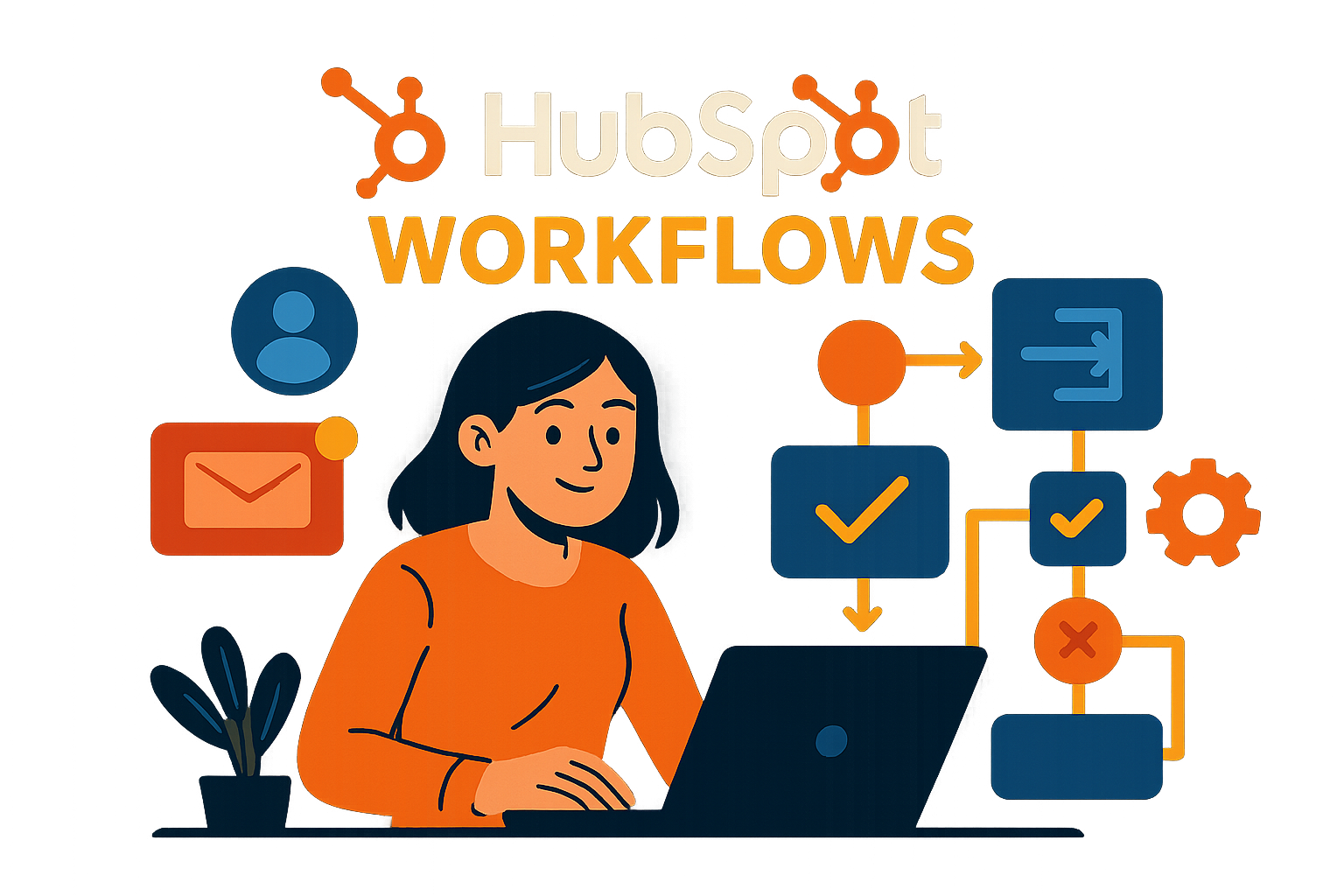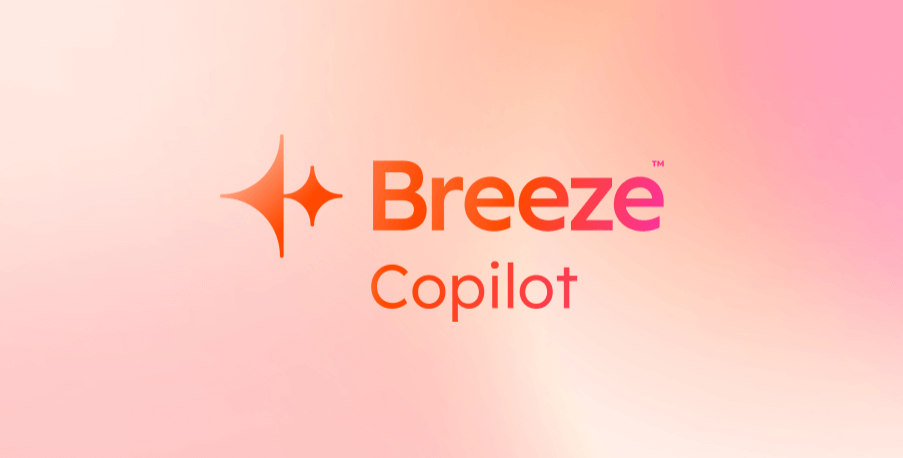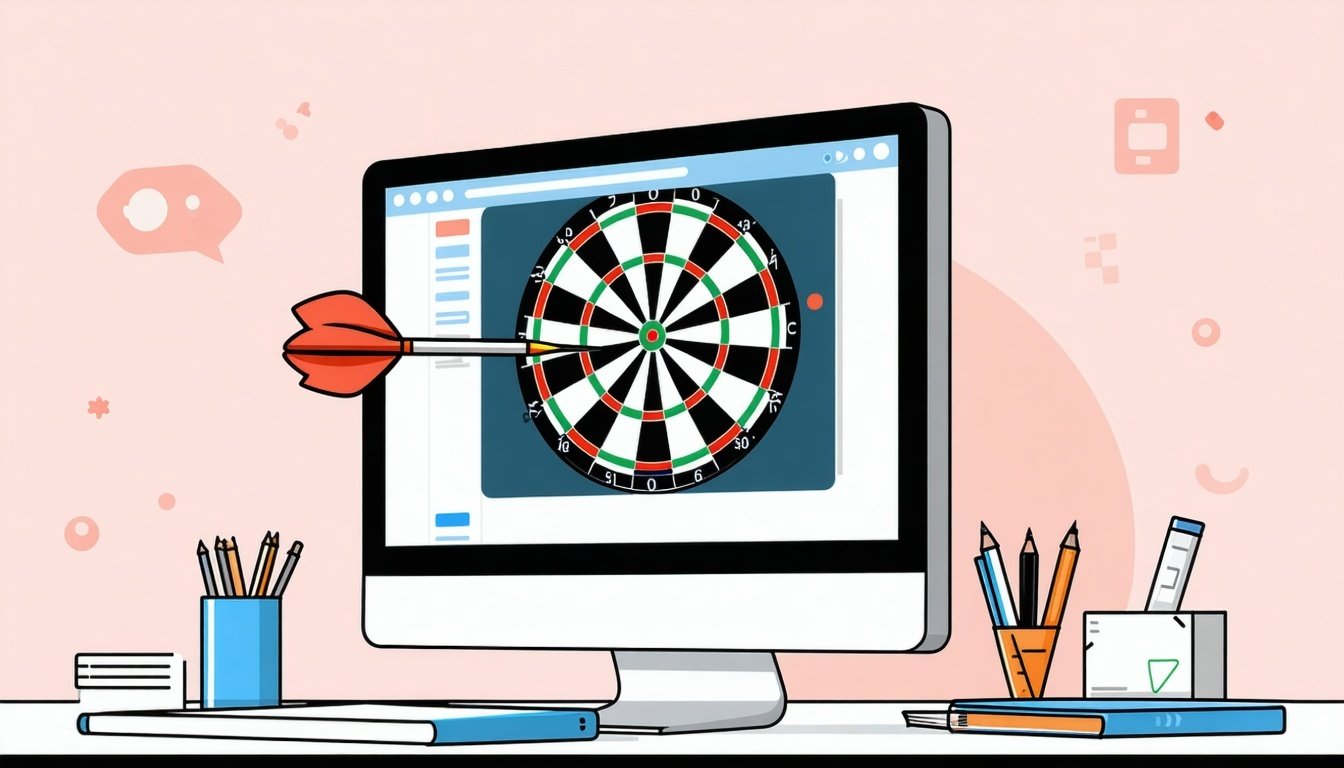Automate Business Operations Using HubSpot Workflows for 2026 Success
On The Fuze
Nov 21, 2025

You're running a business with a dozen fires burning simultaneously—leads slipping through cracks, sales reps manually assigning contacts at midnight, and customer onboarding processes that feel like herding cats.
If that sounds familiar, it's probably because you haven't implemented HubSpot Workflows. HubSpot Workflows can automate 80% of those headaches. But most business owners either aren't using them or are using them wrong.
What is a HubSpot workflow?
- Enrollment Trigger: The condition that starts the automation (form submission, property change, or behavioral event)
- Actions: The automated steps executed on enrolled records (send email, update data, create tasks)
- Goal: The success criteria that exits records from the workflow (contact becomes customer, deal closes)

Why Do Businesses Need Workflow Automation?
- Time Savings and Efficiency: Manual tasks consume 15-20 hours per employee weekly. Workflows automate lead assignment, follow-up scheduling, internal notifications, and customer feedback collection. Your team redirects this time toward high-value strategic work instead of administrative upkeep.
- Process Consistency at Scale: Human error is inevitable. We forget steps, skip processes during busy periods, or apply different approaches to similar situations. Workflows execute your documented procedure perfectly every single time, regardless of volume. Every lead receives identical treatment. Every customer experiences the same onboarding.
- Data Quality and Governance: Inconsistent data formats—varying capitalization, non-standard phone numbers, outdated lifecycle stages—sabotage reporting and personalization. Workflows enforce data standards automatically, maintaining clean CRM records without manual cleanup efforts.
What Subscription Level Do I Need for Workflows?

- Professional: Up to 300 workflows, covers Contacts, Companies, Deals, Tickets
- Enterprise: Up to 1,000 workflows, includes Custom Objects automation
- Data Hub Enterprise: Maximum of 1,100 workflows
- Quotes, Tickets, Feedback Submissions, Leads, Projects workflows require Sales Hub or Service Hub Professional/Enterprise
- Custom Objects automation is Enterprise-only
- Starter tier provides limited email automation without complex logic or multi-step capabilities
How Do HubSpot Workflows Handle Enrollment Logic?

- Form submission happens
- Property value changes to specific status
- Custom event completes
- Website page gets visited
- Industry = Healthcare
- Country = United States
- Lifecycle Stage = Lead

All existing records meeting criteria can enroll immediately upon activation.
What Are If/Then Branches in HubSpot Workflows?

- Property values (Lead Score > 50?)
- Recent engagement (Opened last email?)
- Goal achievement status (Has contact become customer?)
- Date comparisons (Is today after [specific date]?)
- Behavior-based content personalization
- Priority-based assignment routing
- Engagement-dependent follow-up timing
- Industry-specific messaging
How Do Delays Work in Workflows?
Delay Types:
.webp?width=640&height=546&name=Delay%20Types%20(1).webp)
- Specific duration: 5 minutes, 2 days, 1 week, 3 months
- Commonly used for nurture sequence spacing
- Ensures appropriate breathing room between touchpoints
- Wait until specific date property (webinar date, subscription renewal)
- Wait until relative date (7 days before deal close date)
- Enables event-driven timing
- Restrict actions to business hours only
- Prevent weekend email sends
- Respect time zones for global contacts
What Happens When Records Achieve the Goal?

- All pending scheduled actions cancel immediately
- Record unenrolls from Workflow automatically
- Enrollment counts toward goal achievement metric
- Record cannot re-enroll (unless re-enrollment setting is enabled)
- Contact Lifecycle Stage = Customer
- Deal Stage = Closed Won
- Ticket Status = Closed
- Custom property = Completed
How Do I Create My First Workflow?
- Navigate to Workflows: Go to Automation > Workflows in your HubSpot portal. Click "Create workflow" in the upper right corner.
- Choose Your Starting Point: Select either "From scratch" for full control or use a pre-built Template for guided setup. Templates provide excellent guardrails for beginners.
- Choose a trigger to start the workflow: Choose how records will be enrolled to your workflow:
- Trigger manually
- Met filter criteria
- On a schedule
- Companies for account-level updates
- Define Enrollment Trigger: Set specific criteria that start the automation:
- Event-based triggers (form submission, property change, website visit)
- State-based filters (current property values like "Lifecycle Stage = Lead")
- Based on a schedule. (daily at 8:00 AM)
- Combine multiple conditions for precision targeting
- Add Actions: Click the plus icon below your trigger. Select actions that execute on enrolled records:
- Send email
- Update property value
- Create task
- Assign owner
- Send internal notification
- Insert Flow Control: Add Delays to manage timing (3 days, 1 week, until specific date). Use If/Then Branches to personalize paths based on behavior or properties.
- Set Your Goal: Define the success outcome that exits records from the Workflow. Common goals include "Contact becomes Customer" or "Deal closes." This prevents unnecessary continued automation.
- Test Before Launching: Use internal test contacts. Verify every branch path. Check action logs after test runs. Review automation issues before turning it On. Monitor closely for 48 hours post-launch.
💡 Pro Tip: To see the step by step of a workflow creation in action, watch our YouTube video Workflows HubSpot YouTube.
What Are the Most Common Workflow Use Cases?
Use Case 1: Instant Lead Assignment
- Trigger: Contact submits Demo Request form AND Lead Status = New
- Action 1: Update Lifecycle Stage to "Sales Qualified Lead"
- Action 2: Rotate Lead Owner among available sales reps
- Action 3: Send Slack notification to assigned rep
Use Case 2: Lead Nurture Campaign
- Trigger: Contact downloads "SEO Guide" content offer
- Action 1: Send a thank-you email immediately
- Delay: 3 days
- If/Then Branch: Has the contact visited the Pricing Page in the last 7 days?
- Yes path: Send high-intent ROI-focused email
- No path: Send standard nurture content
Use Case 3: Deal Handoff Automation

- Trigger: Deal Stage changes to "Closed Won"
- Action 1: Create Service Ticket for Client Success Team
- Action 2: Create high-priority task for Success Manager
- Action 3: Send internal notification to Sales Manager
Use Case 4: Data Formatting and Hygiene

- Trigger: City Property is known or updated
- Action: Format Data—capitalize first letter of city name
- Action: Log change for audit trail
Use Case 5: Support Ticket Triage
- Trigger: Ticket Source = Support Form AND Priority = High
- Action 1: Assign Ticket Owner to L3 Escalation Team
- Action 2: Update Time-to-Response SLA to 4 hours
- Action 3: Send SMS/Slack notification to on-call manager
Can Workflow Actions Be Reversed or Undone?
- Sent emails cannot be unsent
- Property updates are permanent
- Created tasks remain in the system
- Webhook calls to external systems already occurred
- The workflow details page (Actions > Unenroll records)
- Individual contact record cards
- Update records manually one-by-one
- Create a separate "reversal workflow" that identifies and corrects affected records
- Use bulk property updates via Lists
How Do I Troubleshoot Workflow Errors?
- Identify Problem Workflows: Navigate to Automation > Workflows. Click "Review automation issues" to see compiled error lists.
- Diagnose Root Cause: Errors fall into two categories:
- Workflow Setup Issues:
- Referenced email was deleted
- Incomplete If/Then branch path
- Missing required property value
- Permission restrictions on assets
- Record-Specific Issues:
- Contact previously unsubscribed
- Email address is invalid
- Contact marked as non-marketing
- Graymail suppression active
- Workflow Setup Issues:
- Review Action Logs: For individual record troubleshooting:
- Open the contact/deal/ticket record
- Navigate to workflow enrollment history
- Click into specific workflow enrollment
- Review Action Log (90-day retention) for exact failure point
- Address Email Failures: Common email action failures:
- Unsubscribe Status: Contact previously unsubscribed from email type. Verify subscription settings on contact record.
- Graymail Suppression: System blocked send to "unengaged" contact. Uncheck "Don't send to unengaged contacts" in email settings if delivery is mandatory.
- Marketing Contact Status: Contact isn't designated as Marketing Contact. Workflow can automatically set this status, but it creates a billable contact affecting subscription costs.
- Fix and Re-enroll: After correcting the issue:
- Failed records don't automatically retry
- Manually re-enroll individual records if needed
- Consider creating a List of failed enrollments for bulk re-enrollment
How Do Workflows Differ from Sequences?
- 1-to-many process automation
- Complex branching logic required
- Multiple object types involved (Contacts, Deals, Tickets)
- Cross-departmental coordination needed
- Data management and hygiene tasks
- Marketing nurture campaigns at scale
- 1-to-1 personalized sales outreach
- Individual sales reps require manual control
- Pausing for personalization mid-process
- Following up with specific prospects
- Sales rep wants visibility into pending steps
|
Feature
|
Workflows
|
Sequences
|
|
Scale
|
1-to-many
|
1-to-1
|
|
Objects
|
All types
|
Contacts only
|
|
Logic
|
Complex branches
|
Linear steps
|
|
Control
|
Fully automated
|
Manual override option
|
|
Use Case
|
Process automation
|
Sales follow-up
|
What Are the Most Common Beginner Workflows Mistakes?
Mistake 1: Building Monolithic Workflows
- The Error: Combining nurture, lead scoring, internal alerts, and data updates into one massive 30-step workflow.
- Why It Fails: Complex workflows become impossible to debug. Nobody understands how they work six months later. Changes break unexpected parts. Troubleshooting takes hours.
- The Fix: Build modular. One workflow equals one purpose. Link multiple simple workflows together. Example: Separate workflows for nurture, separate for scoring, separate for alerts.
Mistake 2: Ignoring Asynchronous Processing
- The Error: Updating a property in Action 1, then immediately checking that property value in an If/Then branch at Action 2.
- Why It Fails: HubSpot processes data asynchronously. The branch evaluates before the property update completes. Records take the wrong path despite meeting criteria.
- The Fix: Insert a 5-minute delay before any If/Then branch that depends on previous action data. Always. No exceptions.
Mistake 3: Vague Enrollment Criteria
- The Error: Using broad triggers like "Any form submission" or "Lifecycle Stage = Lead" without additional filters.
- Why It Fails: Unintended records enroll. Internal employees receive customer emails. Test contacts trigger sales alerts. Already-customers enter nurture sequences.
- The Fix: Layer multiple conditions. Use AND logic extensively. Implement suppression lists for internal domains. Combine lifecycle stage, specific forms, and behavioral criteria.
Mistake 4: Missing Exit Goals
- Why It Fails: Contacts never exit. They receive emails indefinitely. Customers continue getting prospect nurture content. Unsubscribe rates skyrocket.
- The Fix: Set goals on every workflow. Common goals: Contact becomes Customer, Meeting booked, Deal closed. Exit records immediately upon success.
Mistake 5: Insufficient Testing
- The Error: Testing with one happy-path scenario, then activating for thousands of records.
- Why It Fails: Edge cases break. Suppression lists don't work as expected. Branch logic sends records down wrong paths. Property updates target incorrect fields.
- The Fix: Test with 10+ scenarios covering:
- Records that should enroll
- Records that should be excluded
- Each branch path option
- Records already meeting goal criteria
- Edge cases with missing data
How Do Workflows Compare to External Automation Platforms?
- Automation centers within HubSpot CRM
- HubSpot is your source of truth
- Non-technical teams manage processes
- Standard business objects (Contacts, Deals, Tickets)
- Native HubSpot actions cover requirements
- Complex multi-system orchestration required
- Sophisticated data transformation needed before sync
- HubSpot is NOT primary source of truth
- Code-level data control necessary
- Self-hosting is priority
- Heavy API customization required
|
Feature
|
HubSpot Workflows
|
Make/n8n
|
|
CRM Integration
|
Deep native access
|
API-based access
|
|
Learning Curve
|
Low (visual, guided)
|
Medium-High
|
|
Data Access
|
HubSpot-centric
|
Any API endpoint
|
|
Logic Depth
|
High (native context)
|
Very High (custom code)
|
|
Hosting
|
SaaS only
|
Self-hosting option (n8n)
|
What Are Workflow Capacity Limits?
- Professional Tier: Up to 300 workflows
- Enterprise Tier: Up to 1,000 workflows
- Data Hub Enterprise: Up to 1,100 workflows (highest limit)
- Brands Add-on: Additional 100 workflows per brand
- Event Definitions: 500 unique custom events (all tiers)
- Event Completions: 30 million per month (all tiers)
- Action Logs: 90 days
- Enrollment History: 6 months
How Do I Scale Workflows Across My Organization?
- Structure: [Department] | [Object] | [Purpose/Campaign] | [Status]
- Examples:
- MKTG | Contact | Q1 Webinar Follow-Up | Active
- SALES | Deal | Proposal Sent Alert | On-Demand
- SVC | Ticket | High-Priority Escalation | Active
- Purpose statement (what problem does this solve?)
- Re-enrollment logic rationale (why is it enabled/disabled?)
- Goal criteria explanation
- Major If/Then branch decision logic
- External dependencies (other workflows, lists, custom properties)
- Use HubSpot's Revision History to track modifications
- Maintain external change log for strategic decisions
- Require peer review before major changes to critical workflows
- Document both what changed and why
- Type (Contact-based, Deal-based)
- Team (Marketing, Sales, Service)
- Creator (who built it)
- Action Type (sends email, updates property)
Modular Architecture
- Lead capture workflow (data entry and cleanup)
- Lead scoring workflow (separate evaluation process)
- Lead assignment workflow (distribution to sales)
- Nurture workflow (educational content delivery)
What Advanced Features Extend Workflow Capabilities?
Webhooks: External System Integration
- What They Do: Webhooks send or receive data between HubSpot and external applications lacking native integration.
- POST Requests: Push HubSpot data out to external systems. When a deal closes, send contract details to your ERP system. When support ticket resolves, update your billing platform.
- GET Requests: Pull external data into HubSpot. When enrollment occurs, retrieve current inventory status from warehouse system and update deal properties accordingly.
- Sync CRM data to custom-built applications
- Trigger processes in project management tools
- Update financial systems with sales data
- Retrieve real-time information from third-party APIs
Custom Code Actions
- Advanced mathematical calculations
- Sophisticated string manipulation
- Complex data lookups across multiple properties
- Conditional logic beyond standard If/Then branches
- Requires Operations Hub Professional/Enterprise
- Creates technical debt (developer skills needed for maintenance)
- Harder to troubleshoot than visual actions
- Documentation becomes critical
Format Data Actions
- Capitalize first letter of names and cities
- Convert phone numbers to consistent format
- Trim whitespace from form submissions
- Standardize date formats
- Convert text case (uppercase, lowercase, title case)
What Security and Compliance Considerations Apply?
- Limit workflow edit access to authorized roles
- Separate view versus edit versus publish permissions
- Restrict access to workflows containing sensitive data operations
- Control who can modify webhooks and external integrations
- Restrict sensitive properties (salary, SSN, financial data) to specific roles
- Users without property access cannot edit workflows referencing those properties
- Workflows may appear view-only or grayed out for unauthorized users
- Plan workflow creation around existing security architecture
- Action logs provide 90-day detailed activity records
- Enrollment history offers 6-month overview
- Export critical workflow activity before retention expires
- Use custom properties to log permanent audit trails
- Sending marketing email automatically converts contacts to "Marketing Contact" status
- This creates billable contacts affecting subscription costs
- Suppression lists prevent accidental conversion
- Re-engagement workflows may unintentionally inflate marketing contact count
Key Takeaways: Your Workflow Success Blueprint
- Workflows are automated sequences triggered by specific criteria, executing actions on enrolled records
- Three pillars: Enrollment Trigger (what starts it), Actions (what happens), Goal (what ends it)
- Professional or Enterprise subscriptions required for full functionality
- Start modular with single-purpose workflows
- Test obsessively before activation—actions cannot be undone
- Insert 5-minute delays before If/Then branches depending on previous action data
- Always set exit goals to prevent infinite loops
- Building monolithic all-in-one workflows instead of modular linked systems
- Using vague enrollment criteria without layered filters
- Ignoring asynchronous processing delays
- Launching without comprehensive edge case testing
- Implement strict naming conventions: [Department] | [Object] | [Purpose] | [Status]
- Document purpose, re-enrollment logic, and decision criteria for every workflow
- Conduct regular audits to identify redundant or conflicting automations
- Prioritize metrics tracking on your 20 most business-critical workflows
- Lead assignment and qualification (sales)
- Educational nurture sequences (marketing)
- Post-sale handoff coordination (operations)
- Data hygiene and formatting (data quality)
- Support ticket triage and escalation (service)
- Use Workflows for: 1-to-many automation, cross-departmental processes, CRM-centered tasks
- Use Sequences for: 1-to-1 sales outreach with manual personalization
- Use iPaaS platforms for: Complex multi-system orchestration, heavy data transformation
- Webhooks connect to external systems via POST/GET requests
- Custom code actions enable complex calculations (Operations Hub Pro/Enterprise)
- Format data actions enforce property standardization automatically
- Companies using HubSpot automation see 129% increase in leads after one year
- 36% increase in closed deals
- 37% improvement in ticket closure rates
- 15-20 hours per week reclaimed per employee
Download Your HubSpot Workflow Templates
Start using workflows today and save your team 10+ hours of manual/repetitive tasks
Inside you will find:
- Ready-to-use templates, including lead nurturing, deal approvals, ticket automation, and data cleansing—covering all Hubs.
- Visual setup guides with screenshots showing exact enrollment triggers, delays, and branches for each workflow.
- Battle-tested by hundreds of businesses so you get workflows that work in multiple industries.



